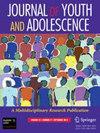Unpacking Profiles of School Burnout in High-Achieving Students in Türkiye: A MSEM Analysis.
IF 3.6
1区 心理学
Q1 PSYCHOLOGY, DEVELOPMENTAL
引用次数: 0
Abstract
Although high-achieving students are often perceived as well-adjusted, there is limited understanding of the varied ways they experience school burnout. Prior research tends to treat burnout as a uniform phenomenon, overlooking subgroups that may differ in psychological risk and academic outcomes. This study addresses this gap by identifying distinct profiles of school burnout and examining their psychological and academic correlates in high-achieving adolescents, defined by their mean grade of 85 or above out of 100 and placement in the top 2%, which earned them admission to science high schools based on their performance on Türkiye's High School Entrance Exam (LGS). Participants included 443 students (225 females, 50.8%) aged 14 to 19 years (M = 15.9, SD = 1.11). Given the broad age range spanning early to late adolescence, developmental variability in academic expectations and emotional regulation is likely, which may influence how students experience burnout. Using Mixture Structural Equation Modeling (MSEM), in which latent profiles and structural pathways were estimated simultaneously, the study found that parental achievement pressure, self-oriented perfectionism, and socially prescribed perfectionism predicted fear of failure, which in turn negatively impacted grade point average. Both fear of failure and grade point average were significant predictors of burnout, with fear increasing burnout and grade point average serving as a protective factor. Latent Profile Analysis revealed three distinct student profiles: "Calm but Underachieving", "Burnout Under Pressure", and "Self-Driven High Achiever". Three-step regression analyses revealed that psychological symptoms varied meaningfully across profiles. Specifically, the "Calm but Underachieving" group had significantly higher odds of depression compared to the "Self-Driven High Achiever" group, despite reporting lower stress levels. Meanwhile, anxiety levels did not significantly differ across any profile, indicating that anxiety may be a more generalized emotional response among students regardless of their academic engagement. These findings underscore the importance of considering developmental differences and psychological risks unique to high-achieving adolescents. By identifying distinct burnout profiles, this study provides nuanced insights that address gaps in current understanding and support the development of targeted mental health interventions for high-achieving adolescents.虽然成绩优异的学生通常被认为适应能力很强,但人们对他们经历学校倦怠的各种方式的理解有限。先前的研究倾向于将倦怠视为一种统一的现象,忽略了可能在心理风险和学业成果方面存在差异的亚群体。本研究通过识别学校倦怠的不同特征,并检查高成就青少年的心理和学业相关性,解决了这一差距。高成就青少年的平均成绩为85分或以上(满分100分),排名前2%,根据他们在 rkiye高中入学考试(LGS)中的表现,他们可以进入科学高中。参与者包括443名14至19岁的学生(225名女生,50.8%)(M = 15.9, SD = 1.11)。考虑到青少年早期到晚期的广泛年龄范围,学业期望和情绪调节的发展变异性可能会影响学生如何经历倦怠。采用混合结构方程模型(MSEM),同时估计潜在特征和结构路径,研究发现父母成就压力、自我导向完美主义和社会规定完美主义预测失败恐惧,而失败恐惧反过来又对平均成绩产生负向影响。对失败的恐惧和平均绩点都是倦怠的显著预测因子,其中恐惧增加倦怠和平均绩点是保护因素。潜在特征分析揭示了三种不同的学生特征:“冷静但表现不佳”、“压力下的倦怠”和“自我驱动的高成就”。三步回归分析显示,心理症状在不同的剖面上有显著的差异。具体来说,与“自我驱动的高成就者”组相比,“冷静但成绩不佳”组患抑郁症的几率要高得多,尽管他们的压力水平较低。同时,焦虑水平在任何情况下都没有显著差异,这表明焦虑可能是学生中更普遍的情绪反应,无论他们的学业投入如何。这些发现强调了考虑高成就青少年特有的发育差异和心理风险的重要性。通过识别不同的倦怠特征,本研究提供了细致入微的见解,解决了目前对高成就青少年的理解差距,并支持了有针对性的心理健康干预措施的发展。
本文章由计算机程序翻译,如有差异,请以英文原文为准。
求助全文
约1分钟内获得全文
求助全文
来源期刊

Journal of Youth and Adolescence
PSYCHOLOGY, DEVELOPMENTAL-
CiteScore
8.20
自引率
6.10%
发文量
155
期刊介绍:
Journal of Youth and Adolescence provides a single, high-level medium of communication for psychologists, psychiatrists, biologists, criminologists, educators, and researchers in many other allied disciplines who address the subject of youth and adolescence. The journal publishes quantitative analyses, theoretical papers, and comprehensive review articles. The journal especially welcomes empirically rigorous papers that take policy implications seriously. Research need not have been designed to address policy needs, but manuscripts must address implications for the manner society formally (e.g., through laws, policies or regulations) or informally (e.g., through parents, peers, and social institutions) responds to the period of youth and adolescence.
 求助内容:
求助内容: 应助结果提醒方式:
应助结果提醒方式:


